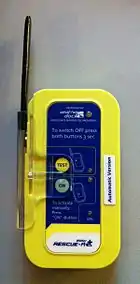AIS-SART
The AIS-SART is a self-contained radio device used to locate a survival craft or distressed vessel by sending updated position reports using a standard Automatic Identification System (AIS) class-A position report. The position and time synchronization of the AIS-SART are derived from a built in GNSS receiver (e.g. GPS).[1] Shipboard Global Maritime Distress Safety System (GMDSS) installations include one or more search and rescue locating devices. These devices may be either an AIS-SART (AIS Search and Rescue Transmitter) (from January 1, 2010), or a radar-SART (Search and Rescue Transponder).

The AIS-SART derives position and time synchronization from a built in GNSS receiver. Once per minute, the position is sent as a series of eight identical position report messages (four on 161.975 MHz and four on 162.025 MHz). This scheme creates a high probability that at least one of the messages is sent on the highest point of a wave.
AIS SARTs are typically cylindrical and brightly colored. A typical model is 251mm (about 10 inches) high and weighs 450g (about a pound).[2]
The specification (IEC 61097-14 Ed 1.0) for AIS-SART was developed by the IEC's TC80 AIS work group. AIS-SART was added to the GMDSS regulations effective January 1, 2010.[3]
See also
References
- Robert Connolly (June 2010). "A new AIS SART, Coastwatch and Irish airshows". Radio User. 5 (6): 40–41. ISSN 1748-8117.
- "SART / AIS-SART". JOTRON. Retrieved 2012-04-27.
- IEC Technical Committee 80. "Maritime Navigation and Radiocommunication Equipment and Systems" (PDF). IEC. Archived from the original (PDF) on 2012-10-03. Retrieved 2012-04-25.